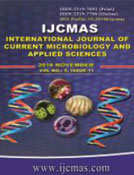


 National Academy of Agricultural Sciences (NAAS)
National Academy of Agricultural Sciences (NAAS)

|
PRINT ISSN : 2319-7692
Online ISSN : 2319-7706 Issues : 12 per year Publisher : Excellent Publishers Email : editorijcmas@gmail.com / submit@ijcmas.com Editor-in-chief: Dr.M.Prakash Index Copernicus ICV 2018: 95.39 NAAS RATING 2020: 5.38 |
Haloarchaea thrive in hypersaline environments such as marine salterns, saline soils, soda lakes, salted foods, etc. The lysis of marine phyto- and zoo-planktons such as algae, diatoms, shrimps, purple and green bacteria, fish, etc. releases biopolymers namely cellulose, starch, chitin, proteins, lipids, etc. in the saline ecosystems. The chemorganotrophic haloarchaea therefore, need to produce hydrolytic enzymes to utilize these substrates. However, the raw solar salt used for preservation can cause spoilage of foods due to the growth of halobacteria leading to economic loss. We report here the isolation and identification of extracellular hydrolases (substrates casein, gelatin, starch, and Tweens: 20, 60, 40, 80) producing haloarchaea isolated from the salt and brine samples collected from marine salterns at Okhamadhi, Gujarat, India. Morphological, physiological, detection of diether lipids, carotenoids, antibiotic sensitivity and molecular (16S rRNA) sequencing was carriedout. Majority of the isolates showed their potential to hydrolyze at least one substrate, while one strain BVM005 belonging to the genus Haloferax showed multiple hydrolytic activities against four substrates (casein, gelatin, starch and Tween 80).The 16S rRNA sequences of these strains were deposited in the GenBank, accession numbers: KP636732-33, 34, 35, 36, and 37. This is the first paper concerning the identification of hydrolases producing haloarchaea based on 16S rRNA sequencing from Okhamadhi, Gujarat.
 |
 |
 |
 |
 |